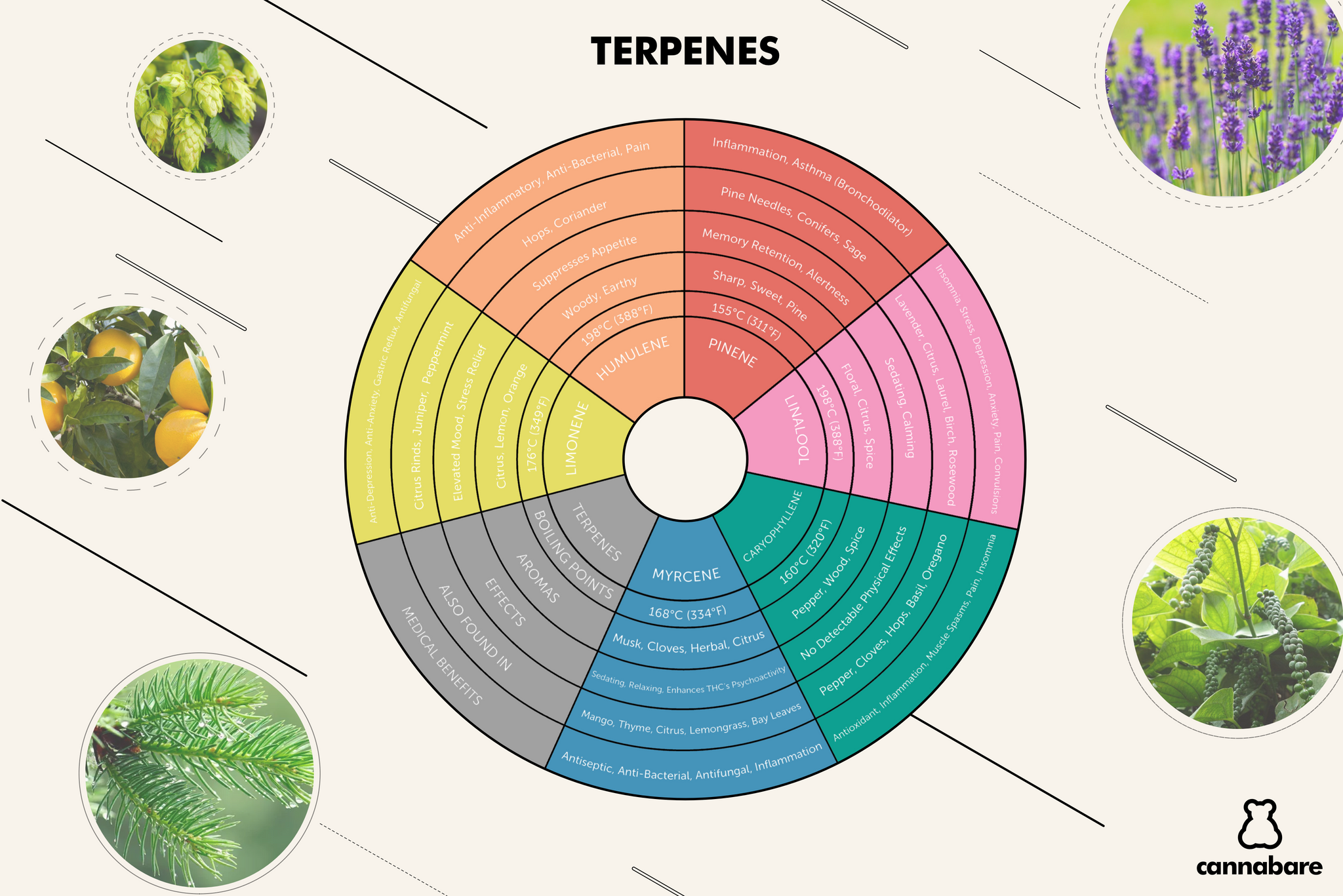Biology and Chemistry of CBD
TERPENES
In addition to the cannabinoids, other molecules in the cannabis plant are biologically active (not to mention fragrant and flavorful). Terpenoids, known as terpenes, are very common chemical compounds in plants and animals that function as major biosynthetic cellular messengers. Many hormones, including estrogens, are terpenoids and share the same basic organic chemical structure.
All cannabinoids are chemically classified as terpenes, but they are unique to cannabis; this section will cover terpenes shared between cannabis and other plants.

Terpenes are oils secreted by the glandular hairs found most densely on the floral leaves and flowers of female plants. Their flavor and smell identify the particular strain along with their known health effects. Pine, grapefruit, lemon, and lavender are often used to describe the smell or taste of different varieties of cannabis.
MYRCENE
The most common terpene produced by cannabis is myrcene (β-myrcene). In some cannabis varieties, myrcene comprises up to 60 percent of the essential oils. Indica strains that have above 0.5 percent levels of myrcene can cause sedation. Myrcene’s aroma has been described as musky, earthy, and herbal, somewhat similar to cloves. Examples of plants whose oils contain myrcene include hops, citrus fruits, bay leaves, eucalyptus, wild thyme, lemongrass, as well as many other plants.
Myrcene has specific medicinal properties. It works as a muscle relaxant and sedative. It has been known to lower the resistance across the blood-to-brain like THC to take effect more quickly. Furthermore, myrcene can increase the saturation level of the CB1 receptor, which in turn can maximize the psychoactive effect of cannabis.
Known as a potent analgesic, anti-inflammatory, antibiotic, and antimutagenic, myrcene blocks the action of cytochrome and other pro-mutagenic carcinogens. A 2014 study revealed that myrcene acts as an inhibitor of gastric and duodenal ulcers and suggested it may be helpful in preventing peptic ulcer disease. Furthermore, myrcene’s sedative and relaxing effects also make it ideal for the treatment of insomnia and pain.
LIMONENE
Cannabis varieties high in limonene have strong citrusy odors like oranges, lemons, and limes and promote a general uplift in mood and attitude. A monocyclic monoterpenoid, limonene is one of two major compounds formed from pinene and is the major constituent in citrus fruit rinds, rosemary, juniper, and peppermint, as well as in several pine needle oils.
Limonene is absorbed quickly in the bloodstream after inhalation. It aids in the absorption of other terpenes through the skin and other body tissue. Limonene is an ideal anti-fungal agent for ailments such as toenail fungus, suppressing the growth of many species of fungi and bacteria. It may be beneficial in protecting against various cancers. Limonene reversed mammary tumors in mice and stimulated apoptosis—programmed cell death —in breast cancer. Furthermore, it has been found to help promote weight loss.
Limonene is a natural insecticide that plants use to ward off predators, and, while its main use was in food and perfumes until a couple of decades ago, it is now best known as the primary active ingredient in citrus cleaner as it has very low toxicity or adverse effects.
During testing on the effects of limonene, participants experienced an increase in attention, mental focus, well-being, and even sex drive. Limonene prevents the deterioration of the RAS gene, one of the factors that contributes to the development of tumors, and protects against aspergillus and carcinogens present in smoke.
BETA-CARYOPHYLLENE
With a peppery, woody, and/or spicy aroma, the sesquiterpene beta-caryophyllene is found in Thai basil, clove, cinnamon leaf, and black pepper, and in lavender in small quantities. Research indicates that beta-caryophyllene may be effective in cancer treatment plans. It is the only known terpene to interact with the endocannabinoid system. Studies show that beta-caryophyllene selectively binds to the CB2 receptor and that it is a functional CB2 agonist. Beta-caryophyllene is a functional non-psychoactive CB2 receptor ligand in foodstuff and a macrocyclic anti-inflammatory cannabinoid in cannabis.
Researchers in 2012 suggested that beta-caryophyllene may be an excellent therapeutic agent to prevent nephrotoxicity (impacting the kidneys) caused by anti-cancer chemotherapy drugs such as cisplatin when delivered through a CB2 receptor pathway. That same year, a study focused on the chemical composition and the pharmacological properties of essential oil isolated from black pepper, of which beta-caryophyllene is a main constituent. It was found to possess antioxidant, anti-inflammatory, and antinociceptive properties. Cannabis strains high in beta-caryophyllene, like Omrita RX, may be useful in treating pain related to arthritis and neuropathy.
A 2013 study showed that the combination of phytocannabinoids, specifically cannabidiol (CBD) and beta-caryophyllene, administered orally appears to be a potential treatment for chronic pain.
PINENE
Pinene is a bicyclic monoterpenoid, possessing aromas of pine and fir. Two structural isomers of pinene are found in nature—alpha-pinene and beta-pinene—and both are important components of pine resin. Alpha-pinene is nature’s most prevalent terpenoid, found mostly in balsamic resin, pinewoods, and some citrus fruits, as well as many other conifers and non-coniferous plants. The two isomers constitute the main component of wood turpentine. Pinene is a principal monoterpene, important physiologically in both plants and animals, and tends to react with other chemicals, forming other terpenes, such as limonene, and other compounds.
Pinene has been used as a local antiseptic and an anti-inflammatory expectorant. It is also thought to be a bronchodilator. The smoke of plants rich in pinene give the sensation of sucking more air, which can cause hyperventilation or sometimes cough. Alpha-pinene is a natural compound that can be isolated from pine needle oil and has shown anti-cancer properties. In Traditional Chinese Medicine, it has been used as an anti-cancer agent. THC effects may be diminished when combined with pinene.
Pinene easily crosses the brain barrier to prevent the destruction of molecules responsible for the transmission of information, which results in memory improvement. Rosemary and sage have been considered beneficial over thousands of years of traditional medicine due in part to the presence of pinene in their makeup. Pinene counteracts the effects of THC and tends to improve concentration. Memory lapses tend to occur more often with the use of pure THC versus THC mixed with pinene.
TERPINEOL
The three closely related monoterpenoids, alpha-terpineol, terpinen-4-ol, and 4-terpineol have aromas comparable to lilacs and flower blossoms. Often found in cannabis varieties also high in pinene, terpineol’s fragrances are overpowered by other more redolent terpene. Alpha-terpineol is known to have calming, relaxing effects and exhibits antibiotic, antioxidant, and antimalarial properties. It also has anti-tumor, anti-inflammatory, anxiolytic, properties.
LINALOOL
Cannabis varieties high in the non-cyclic monoterpenoid linalool promote calming, relaxing effects. Linalool has floral and lavender undertones and for centuries has been used as a sleep aid. Linalool tends to diminish the anxiety pure THC can provoke, making it helpful in treating psychosis and anxiety.
One study suggested that linalool may significantly reduce lung inflammation induced by cigarette smoke. It may block the carcinogenesis aggravated by benz[α]anthracene, a component of the tar generated by the combustion of tobacco.
Linalool activates immune cells through specific receptors and/or pathways and may boost the immune system in general. Research has shown that the anti-inflammatory effect of linalool can contribute to the slowdown and reversal of Alzheimer’s disease.
The Environmental Protection Agency has approved its use as a pesticide, flavor agent, and scent. Linalool’s vapors seem to be an effective insecticide to ward off fruit flies, fleas, and cockroaches.




